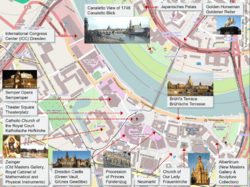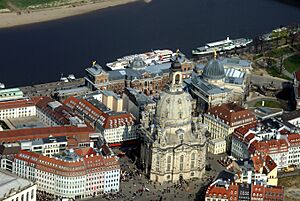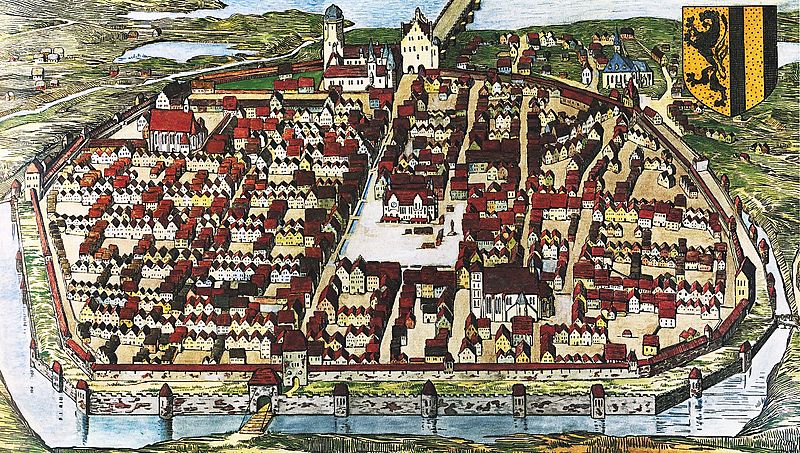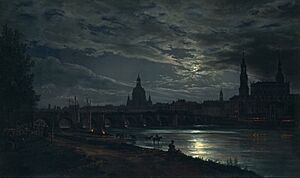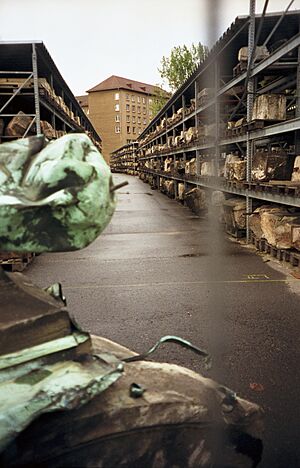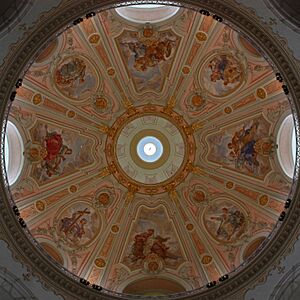Frauenkirche, Dresden facts for kids
Quick facts for kids Frauenkirche |
|
|---|---|
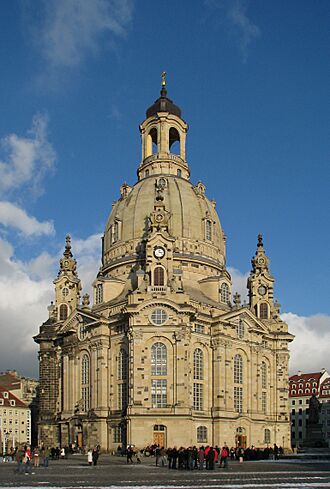 |
|
| Religion | |
| Affiliation | Evangelical-Lutheran Church of Saxony |
| Ecclesiastical or organizational status | Parish church |
| Location | |
| Location | Dresden, Germany |
| Architecture | |
| Architect(s) | George Bähr |
| Architectural style | Baroque |
| Groundbreaking | 1726/1993 |
| Completed | 1743/2005 |
| Website | |
| Official Website: https://www.frauenkirche-dresden.de/en/ | |
The Frauenkirche (which means Church of Our Lady) is a famous Lutheran church in Dresden, Germany. It was sadly destroyed during the bombing of Dresden in World War II. However, it was rebuilt between 1994 and 2005.
This church is the third one built on this spot. The first was a Catholic church that became Protestant during the Reformation. The second, built in the 1700s, was a large Baroque building. It had one of Europe's biggest domes. It was a symbol of Dresden's people wanting to stay Protestant. After being rebuilt, it is now a symbol of peace and friendship between countries that were once at war.
After its destruction in 1945, the church's ruins were left as a war memorial for almost 50 years. This was decided by leaders in East Germany. After Germany became one country again, people decided to rebuild the church. Work started in 1994. The outside was finished in 2004, and the inside in 2005. The church was officially opened again on October 30, 2005. The area around it, called Neumarkt, was also rebuilt.
Many people call the Frauenkirche a cathedral, but it is not. A cathedral is where a bishop has his main church. The main church for the Evangelical-Lutheran Church of Saxony is the Church of the Cross. The Frauenkirche also holds an Anglican service in English once a month.
| Top - 0-9 A B C D E F G H I J K L M N O P Q R S T U V W X Y Z |
History of the Frauenkirche
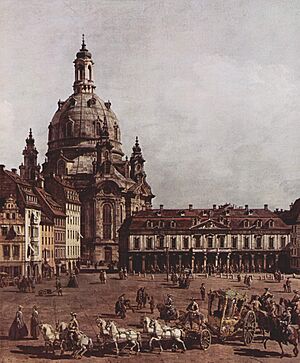
The first church named 'Our Lady' was built here in the 11th century. It was in a Romanesque style and stood outside the city walls. This church was Catholic until the Reformation, when it became Protestant.
This first Frauenkirche was taken down in 1727. A new, much bigger church was built in its place. The citizens of Dresden rebuilt it as a Lutheran church. Even though Saxony's ruler, Frederick August I, became Catholic, he supported building the church. This showed the people of Saxony that he would not force them to change their religion.
The original Baroque church was built from 1726 to 1743. It was designed by Dresden's city architect, George Bähr. He sadly passed away before his greatest work was finished. Bähr's design was special for Protestant churches. He put the altar, pulpit, and baptismal font right in the middle. This way, everyone in the church could see them easily.
In 1736, the famous organ builder Gottfried Silbermann made a large organ for the church. It had three keyboards and 43 stops. The organ was first played on November 25. The famous composer Johann Sebastian Bach gave a concert on it on December 1.
The church's most special part was its unusual high dome. It was 67 metres (220 ft) tall and called "Stone Bell." This dome was an amazing engineering feat. It weighed 12,000 tons and rested on eight thin supports. People worried it might not be strong enough, but it was very stable. In 1760, during the Seven Years' War, the dome was hit by over 100 cannonballs. These were fired by the Prussian army led by Friedrich II. But the cannonballs just bounced off, and the church survived!
The finished church gave Dresden a unique look. It was shown in famous paintings by Bernardo Bellotto and in Dresden by Moonlight (1839) by Johan Christian Dahl.
In 1849, the church was part of the May Uprising. This was a time of revolutionary fighting. Barricades were built around the church. Fighting went on for days. Rebels who had not escaped were rounded up inside the church and arrested.
For over 200 years, the bell-shaped dome stood tall over Dresden's skyline. Important people like Heinrich Schütz and George Bähr were buried there.
Destruction of the Frauenkirche
On February 13, 1945, Allied forces began bombing Dresden. The church stood strong for two days and nights. Its eight sandstone pillars held up the huge dome. This allowed 300 people hiding in the church's crypt to escape. But the intense heat from about 650,000 incendiary bombs dropped on the city became too much. The temperature around and inside the church reached 1,000 °C (1,830 °F).
Finally, at 10 a.m. on February 15, the dome collapsed. The pillars glowed red and exploded. The outer walls broke apart, and nearly 6,000 tons of stone crashed down. They even broke through the thick floor.
The church disappeared from Dresden's skyline. The blackened stones lay in a pile in the city center for 45 years. This was during East Germany's Communist rule. Soon after World War II, people in Dresden started saving unique stone pieces from the church. They numbered them for future use. Many people did not want the ruins cleared away for a car park. In 1966, the ruins were officially called a "memorial against war." Events were held there each year to remember the bombing.
In 1982, the ruins became a place for a peace movement. People also protested peacefully against the East German government. On the bombing anniversary, 400 Dresden citizens came to the ruins with flowers and candles. This was part of a growing civil rights movement in East Germany. By 1989, tens of thousands of protesters gathered in Dresden and other cities. On November 9, 1989, the Berlin Wall fell. This led to German reunification.
Rebuilding the Church
Even during World War II, people wanted to rebuild the church. But because of the political situation in East Germany, reconstruction stopped. The pile of ruins was kept as a war memorial. It was like the ruins of Coventry Cathedral in the United Kingdom, which was also destroyed by bombing. As the ruins continued to decay, Dresden leaders decided in 1985 to rebuild the Frauenkirche.
The reunification of Germany brought new hope for rebuilding. In 1989, a group of 14 people, led by musician Ludwig Güttler, formed a "Citizens' Initiative." A year later, they created "The Society to Promote the Reconstruction of the Church of Our Lady." This group started a big fundraising effort. It grew to over 5,000 members in Germany and 20 other countries. Many smaller groups were formed to help.
The project gained speed. Architects, historians, and engineers sorted thousands of stones. They identified and labeled each one to be reused. Others worked to raise money. IBM helped by creating a virtual reality model of the church. This VR model helped bring in many donations.
Günter Blobel, a German-born American, saw the original church as a boy. His family took shelter near Dresden days before the city was bombed. In 1994, he started "Friends of Dresden, Inc." in the United States. This group helped support the rebuilding of Dresden. In 1999, Blobel won the Nobel Prize for medicine. He gave all his prize money (nearly US$1 million) to help rebuild Dresden. This included money for the Frauenkirche and a new synagogue. It was the largest single donation to the project.
In Britain, the Dresden Trust also helped. Its royal patron is Prince Edward, Duke of Kent. Dr. Paul Oestreicher, a leader of the Dresden Trust, said: "The church is to Dresden what St. Paul's is to London." (He meant St. Paul's Cathedral.) Other groups in France and Switzerland also supported the project.
Rebuilding the church cost €180 million. Dresdner Bank paid for more than half of this. They did this through a "donor certificates campaign," raising almost €70 million. The bank itself gave over seven million Euros. Thousands of watches with tiny pieces of Frauenkirche stone were sold. Special medals were also sold. One sponsor raised nearly €2.3 million by symbolically selling individual church stones.
The money raised went to the "Frauenkirche Foundation Dresden." The rebuilding was also supported by the State of Saxony, the City of Dresden, and the Evangelical-Lutheran Church of Saxony.
The new golden cross on top of the tower was paid for by "the British people and the House of Windsor." It was made by a British company called Grant Macdonald. The main craftsman was Alan Smith. His father was one of the pilots who bombed Dresden.
The Reconstruction Process
The Dresden City Council decided to rebuild the church in February 1992. They used the original plans from Georg Bähr from the 1720s. Work began in January 1993 by sorting the rubble. The first stone was laid in 1994. The crypt was finished in 1996, and the inner cupola in 2000. Seven new bells were made and rang for the first time in 2003. The outside of the church was finished early in 2004. The inside was painted in 2005. The rebuilding was completed in 2005, a year ahead of schedule. This was just in time for Dresden's 800-year anniversary in 2006.
The church was officially opened again with a special service. The rebuilt church is a reminder of its history and a symbol of hope and peace.
The church was rebuilt using as much original material and plans as possible. Modern technology also helped. The pile of rubble was carefully studied, and each stone was removed one by one. Computers helped architects figure out where each original stone belonged.
Out of millions of stones, over 8,500 original stones were saved and reused. About 3,800 of these were put back into the new church. The old stones look darker because of fire damage and weather. So, you can clearly see the difference between the old and new stones.
Two thousand pieces of the original altar were cleaned and put into the new structure.
Builders used thousands of old photos, memories from people, and old purchase orders. These orders described the quality of the mortar or the colors of the paint. For example, like in the 18th century, many eggs were used to make the paint that gives the inside its glowing look.
When it was time to copy the oak doors, builders only had vague descriptions. But people often took photos outside the church doors. So, they asked for old photos. Many people sent in wedding albums! This helped artists recreate the original doors perfectly.
The new golden orb and cross on top of the dome were made in London. They used 18th-century methods as much as possible. It was built by Alan Smith, a British goldsmith. His father, Frank, was part of the aircrew that bombed Dresden. Before going to Dresden, the cross was shown in churches across the United Kingdom for five years. In February 2000, Prince Edward, Duke of Kent, officially handed over the cross. It was placed on the dome on June 22, 2004. The outside of the Frauenkirche was now complete. For the first time since the war, the finished dome and its golden cross stood proudly on Dresden's skyline. The old, twisted, and burned cross now stands next to the new altar inside the church.
Builders decided not to make an exact copy of the 1736 Gottfried Silbermann organ. Instead, Daniel Kern built a new organ with 4,873 pipes. It was finished in April 2005 and first played in October that year. The new organ includes all the sounds of the Silbermann organ. It also has extra features for music written after the Baroque period.
A bronze statue of Martin Luther, a famous reformer, survived the bombings. It has been restored and stands in front of the church again. It was made by sculptor Adolf von Donndorf in 1885.
The church holds two short services every day and two longer services every Sunday. Since October 2005, there has been an exhibition about the Frauenkirche's history and rebuilding at the City Museum in Dresden.
The Frauenkirche Today
Since it reopened, the Frauenkirche has become a very popular place to visit in Dresden. In the first three years, seven million people visited the church. They came as tourists and to attend services. This project has inspired other rebuilding projects across Europe.
In 2009, US President Barack Obama visited the church. He came after meeting with German Chancellor Angela Merkel.
Images for kids


